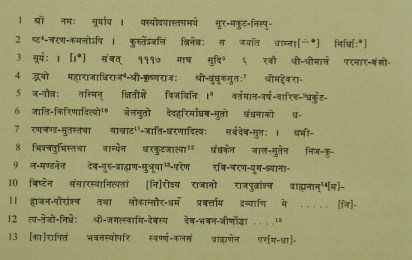|
The Indian Analyst
|
North Indian Inscriptions |
INSCRIPTIONS OF THE PARAMARAS OF BHINMAL another date when the work was completed and the temple was furnished with the cupola and the banner. It is Monday, the eight of the bright half of Jyēshṭha, the 25th pala of the 3rd ghaṭikā of the night (11. 15-16), i.e., after about four months of the date mentioned above. It is further stated that the king Kṛishṇarāja, who was evidently the king in whose dominions the temple was situated, donated a village in the Śrī. . . . . . . . . . . . purīya [1] district, 20 drammas annually and a field in Sachaliyā village and also made some other endowments. [2] In the end, the name of the writer and possibly also of the engraver is given. It cannot be made out as the writing is here lost. ...Of the geographical places mentioned in the present inscription, Śrīmāla is doubtless the town of Bhinnamāla, now known by the popular name Bhinmāl, as seen above. The name of the maṇḍala occurring in 1. 18 is broken; and therefore it cannot be identified. In the vicinity, there are a number of places with their names ending in pura. Sachaliyā mentioned in the same line as containing the field is perhaps Salyā, which appears to be the contracted form of the name. The place lies about 20 kms. due west of Jālōr and at almost the same distance due north of Bhinmāl.
TEXT
[3]
[1] Here the name of the vishaya is partly lost.
|
||||||||||||||||||||||||||||||||||||||||||||||||||||||||||||||||||||||||||||||||||||
| > |
|
>
|








